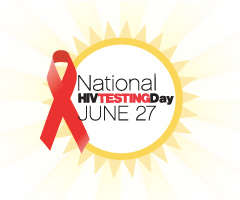Transmission of HIV continues at an unacceptably high rate, and drug use plays an important role—both through exposure to infected body fluids among injection drug users and through the lowered inhibition and risky sexual behaviors that all forms of drug use facilitate. Almost 1.1 million Americans are currently living with the HIV virus, and nearly a sixth of those don’t even know they are infected. That means they aren’t getting needed treatment, and it means they could be passing the infection on to others without knowing.

Even though medical research continues to advance treatments for HIV-infected individuals, there is still no cure, making this disease a life-long, chronic condition that requires daily care. Today, June 27, is National HIV Testing Day, raising awareness of the importance of getting tested for HIV, even if you don’t think you have it, and even if you have tested negative in the past.
Thanks to a wide array of effective antiretroviral medications, a diagnosis of HIV is no longer the death sentence that it was when the disease first emerged over three decades ago. However, an unexpected consequence of our success at managing this disease is that many young people, who do not remember the fear that initially surrounded this virus, have become more complacent about it—they see it as not that serious. They often fail to get tested as a result. They may also fail to get tested because they have tested negative in the past and assume that their current behaviors are adequate to protect them from acquiring HIV. And stigma associated with getting tested is another barrier: Research shows that open communication between partners and reducing stigma are important for encouraging people to get tested.
Increased HIV testing is just one of the measures that NIDA research shows is necessary if we are to effectively reduce the spread of HIV. Increasing access to HIV treatment—i.e., treatment as prevention—is another. Even among those who know they are infected, too few are well connected with care and adherent in taking their medication. And since drug use continues to play a major role in HIV transmission, improved access to substance abuse treatment and needle exchange programs is also crucial to reducing the number of new infections.
At NIDA we will continue our efforts to reduce HIV infection in this country. Please see our AIDS research program to learn about our latest results and new funding opportunities. I also invite you to take a look at how our federal partners are contributing to this goal, via the following links:
- Learn about HIV/AIDS basics on AIDS.gov, or find an HIV testing site and other care services near you using their HIV Testing Sites & Care Services Locator.
- Talk about the National HIV/AIDS Strategy with your friends, family members, and colleagues.
- Learn about how the Affordable Care Act affects people living with HIV.
- See CDC's Act Against AIDS campaigns working to promote testing and end stigma.
